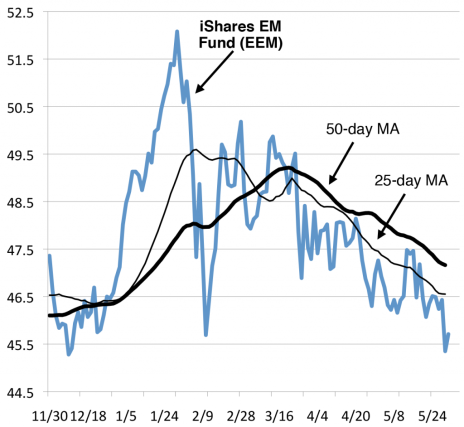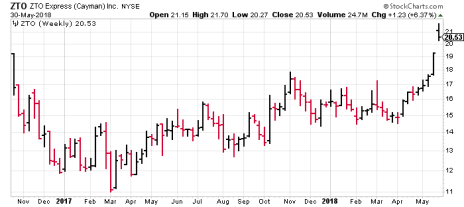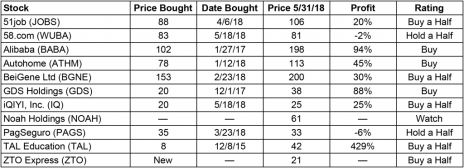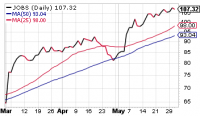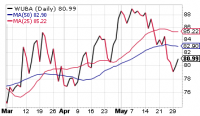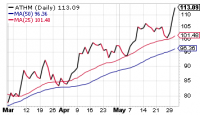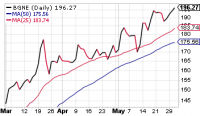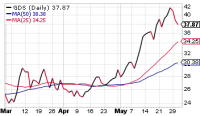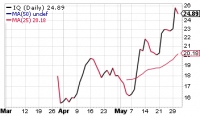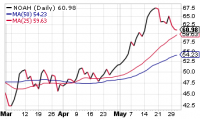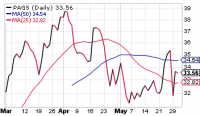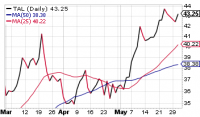Emerging market stocks aren’t doing all that well, but Chinese ADRs are showing considerable strength. That’s the bad-news/good-news summary of today’s commentary. And the theme continues in today’s issue, where we’re adding a stock that has been on a breakout run since the middle of May. Our timing wasn’t right when we took our first position in the stock in late 2017, but the recent rally is offering us a second chance, if we can get the timing right. For the tantalizing details, read on!
Cabot Emerging Markets Investor 660
[premium_html_toc post_id="150989"]
Cabot Emerging Markets Timer
The Emerging Markets Timer is our disciplined method for staying on the right side of the emerging markets. The Timer is bullish when the index is above the lower of its two moving averages and that moving average is trending up.
Our Emerging Markets Timer remains negative, having carved out new closing correction lows during the past week. While there have been a few sharp rallies, the iShares EM Fund (EEM) has been bumping downhill since early March, with the latest geopolitical uncertainties (Italy) keeping the intermediate-term trend pointed down.
As we write, though, the action of U.S.-traded Chinese stocks has been a port in the storm, with many lifting to new highs in recent days. Thus, we continue to take things on a stock-by-stock basis, holding our strong performers and looking for opportunities—all while keeping a bit of cash on the sideline until the broader EM universe gets going.
The Best Good News
Markets are usually nervous about something. It’s such a common condition that it’s only when markets aren’t nervous that experienced market watchers get really concerned.
Right now, the points of tension are the prospects for a trade war between the U.S. and China, the political crisis in Italy (Europe’s fourth-largest economy), where nobody has been able to form a government, and dips in oil and banking stocks.
The bad news has weighed on the Dow and the S&P indexes, pulling them lower in the last half of May.
But the pullback hasn’t hit every index and sector, and the best news for the Cabot Emerging Markets Investor’s portfolio is that Chinese stocks are holding up very well against the sellers. (And it’s also interesting that the Nasdaq, the growthiest of the major U.S. indexes, is also managing to make a little progress despite the mildly negative market tone.)
Here are a couple of charts to show the difference between the performance of the broad emerging markets (as represented by EEM, the iShares EM fund that we use to control the Cabot Emerging Markets Timer) and that of PGJ, the Golden Dragon ETF that tracks Chinese ADRs.
First, the daily chart of EEM, which has been making a series of lower highs since its peak in late January. The only upside here is that the Fund still has technical support between 45 and 46. But you can also see that EEM is decisively below its 200-day moving average and that the 50-day is now below the 200-day.
By contrast, here’s the daily chart for PGJ. You can see the same high in January, but the ETF is 1) trading flat since the middle of May, 2) sitting above its 25- and 50-day moving averages and 3) has its moving averages in “proper” order.
Since I always manage the portfolio on a stock-by-stock basis, the practical consequence of this divergence isn’t major. But it does mean that I will likely give our Chinese holdings a little extra slack in their leashes and will favor Chinese stocks as candidates for inclusion.
On a completely different topic, with the quarterly reports from PagSeguro (PAGS) and Noah Holdings (NOAH), earnings season is officially over for our holdings. We got winged on a couple of our stocks, but generally can’t complain. I’m going to enjoy the next couple of months without having to scan for company-specific icebergs in our path.
Featured Stock
Special Delivery
ZTO Express (ZTO)
Timing is everything in life, and that most definitely includes the stock market. If you buy too early (or too late) in a market cycle, your results can suffer. And the same rule applies to individual stocks.
When we talk about the importance of timing, we’re really talking about some chart reading and, of course, some luck, too. And when I recommended buying ZTO Express (ZTO) early last November, there was no way to know that the stock was just five days away from starting a correction from 17 to 14. I held on until January 12, and we got out of the stock with just a small loss.
But during the next three months of choppy sideways action from ZTO, I couldn’t shake the feeling that it was just a matter of time before the stock attracted attention from big investors.
As a reminder, ZTO Express is one of the largest express delivery and logistics services in China. The company delivers for e-commerce giants like Alibaba and JD.com, and in the first quarter of 2018, handled 1.6 billion parcels, increasing its market share to over 16%. (The top eight delivery companies control about 81% of the market.)
The company uses its own network of 75 sorting hubs, 25,000 pickup and delivery outlets and 4,200 trucks to move parcels while partner companies do much of the “first mile” and “last mile” functions. And the future looks bright, with the number of parcels delivered in China forecast to rise from around 21 billion a couple of years ago to 60 billion in 2020.
ZTO Express has done very well with things as they are, growing revenue at 34% in 2017, but at 45% in Q4 and 48% in Q1 2018. Earnings growth was 35% in Q4 2017 and 70% in Q1.
But the company isn’t standing still. It’s investing in automation equipment for its sorting facilities and is working to integrate the operations of China Oriental Express, a south China freight forwarding and international logistics provider, which ZTO bought in the fourth quarter for $23 million.
ZTO is still a relatively young stock, having come public in late 2016 at 19.5. The stock went into a quick post-IPO correction to 11 in March 2017 then strengthened in a choppy rally to 18 in November 2017. (We bought on a quick pullback to 17.) ZTO went into a sideways phase until a breakout ahead of earnings in March, then gapping down after guidance disappointed investors. A few weeks of very tight trading lasted until early April, when ZTO caught fire.
The fire of the stock’s advance was stoked on Monday by news of a massive strategic investment in ZTO Express by Alibaba and its logistics arm Cainiao Network. The $1.38 billion cash infusion will get Alibaba a 10% stake in ZTO, but it will also cement ZTO Express’s position as the delivery partner-of-choice for Alibaba, China’s e-commerce titan. The investment will be used to integrate Cainiao and ZTO’s first- and last-mile operations, warehouse management, international operations and technology improvements.
ZTO has given back a point of its spike to 21.5 after the news, but it’s still quite extended above its 25-day moving average, which is at 17.6. This gets us back to the question of timing.
My only choices are to delay buying and wait for a pullback or buy a smaller-than-usual position and wait for the stock to build a profit cushion before averaging up. And I choose the more aggressive path, which is to take a half position right now. BUY A HALF.
ZTO Express (ZTO)
Building One
No. 1685 Huazhi Road Qingpu District
Shanghai 201708
China
86 21 5980 4508
http://www.zto.cn
Model Portfolio
Invested 65% Cash 35%
Updates
It’s been a mixed environment for EM stocks, with the overall sector remaining in its downtrend (the strong U.S. dollar of the past few weeks hasn’t helped) but with Chinese stocks actually trending choppily higher. Happily, most of our stocks are in good shape, though there have been a few potholes as well, so we’ll continue to take things on a case-by-case basis.
In last week’s update, we sold Petrobras (PBR) and put our half position in 58.com (WUBA) on Hold. Tonight, we have no changes.
51Job (JOBS) remains in great shape, with the stock marching persistently higher since its earnings report in early May. Volume, too, has been impressive, with a couple of above-average buying days this week. With the 25-day line near 97.5, some sort of pullback or shakeout is possible, but given the nature of the recent surge, we’re not expecting a major retreat. You can buy a half position here or (preferably) on dips of two or three points. BUY A HALF.
58.com (WUBA) was placed on Hold in last week’s update, as investors were displeased with the firm’s first-quarter report; supposedly investors were scared away by some tightening margins and “only” in-line guidance. Our leash isn’t limitless, but right here, we’re content to give WUBA a chance to right itself because (a) there’s a ton of price support in the upper 70s, (b) the major trend is still up, and (c) business is great, with analysts actually hiking their estimates following the report. (now looking for 30% earnings growth this year and 40% next). A break into the mid-70s would probably have us abandoning ship, but if you own a half position here, we advise sitting tight. HOLD A HALF.
Alibaba (BABA) continues to battle with resistance near 200, and it’s possible the stock needs one more shakeout to get traders off its scent. But the combination of the stock’s big launching pad, its earnings-induced rally in early May and the stellar fundamentals makes us think the next major move is up. On the news front, the firm’s payment arm (Ant Financial) did get a $150 billion valuation in a funding round, valuing BABA’s stake at around $50 billion. Hold on if you own some, and if you don’t, you can buy some here. BUY.
Autohome (ATHM) remains in good shape, having spiked off its 25-day line (around 101.5) yesterday to new highs on solid volume. Shares have been advancing in a two-steps-forward, one-step-back manner, so try to get in on dips. BUY.
BeiGene (BGNE) is also in a firm uptrend. We note that the stock hasn’t had much of a pullback all year, so profit-taking sets in at some point—but there’s no sign of that yet. As for the company, the firm presented at an investment conference last week. There was nothing new, though it caught our eye that the firm has a whopping 40 clinical trials ongoing or planned, including for a couple of blockbusters. BUY A HALF.
GDS Holdings (GDS) has finally met with some selling in the 41 area after a quick 11-point (36%!) advance following earnings. Part of the reason for the retreat was this morning’s $250 million offering of convertible notes (which are counted as diluted to shareholders, as these notes usually do get converted into shares). But, of course, the $250 million will come in handy to pay off debt and/or expand and acquire new data centers—indeed, GDS has six data centers under construction or being expanded as of a few weeks ago. You can buy some here or on further weakness. BUY.
iQIYI (IQ) went bananas yesterday, rallying 11% on a big pickup in volume. There was no obvious news to drive it, but it was a hot day for many small Chinese Internet stocks. IQ is sure to remain extraordinarily volatile, but we’re OK buying a small position here or on dips. The stock’s action since its IPO in late-March is encouraging and we could have a tiger by the tail with IQ if the market gets going. BUY A HALF.
Noah Holdings (NOAH) released a good (but not amazing) quarterly report yesterday—revenues rose 17% in local currency, driven by a 54% surge in its asset management business, and many sub-metrics looked good, including the number of active clients rising 25%. That said, average transaction value fell sharply and earnings were up just 8% (again, in local currency). That caused the stock to dip some, though the damage was limited—NOAH is still above its 25-day line (which is closing in on 60), and analysts still see earnings up in the low 20% range both this year and next. Business-wise, the future will probably be better than the past for NOAH, but we’ll stay on Watch and see how the stock handles itself after this selloff. WATCH.
Speaking of volatile, PagSeguro (PAGS) had some wild, but intriguing, action following its earnings report yesterday. As for business, it certainly remains in excellent shape—revenues soared 98%, earnings leapt 133%, local currency payment volume was up a huge 139% and active merchants on its platform rose 83% (to 3.1 million). Still, by some estimates, earnings came in below expectations and the take rate (how much of a cut the firm gets on every transaction) fell 41 basis points, which caused the stock to plunge below 30 briefly yesterday. But it found big-volume support and closed at 34, a good sign big investors bought the dip. All in all, PAGS still has lots of work to do, but we’re OK holding our half position to see if yesterday’s washout leads to higher prices. HOLD A HALF.
Petrobras (PBR) was sold on a Special Bulletin last Thursday. It’s actually continued lower since then as the firm gets caught in a web of local issues. While shares could bounce, the uptrend has been broken. SOLD.
TAL Education (TAL) has been hesitating in the 42 to 44 area for the past week, but that comes after a solid (albeit low volume) advance to new highs before that. Continue to sit tight if you own some, and if you don’t, you can buy a half position around here. BUY A HALF.
[premium_html_footer]
Send questions or comments to paul@cabotwealth.com.
Cabot Emerging Markets Investor • 176 North Street, Salem, MA 01970 • www.cabotwealth.com
All Cabot Emerging Markets Investor buy and sell recommendations are made in issues or updates and posted on the Cabot subscribers’ website. Sell recommendations may also be sent to subscribers as special alerts via email. To calculate the performance of the hypothetical portfolio, Cabot “buys” and “sells” at the midpoint of the high and low prices of the stock on the day following the recommendation. Cabot’s policy is to sell any stock that shows a loss of 20% in a bull market (15% in a bear market) from our original buy price, calculated using the current closing (not intra-day) price. Subscribers should apply loss limits based on their own personal purchase prices.
THE NEXT CABOT EMERGING MARKETS INVESTOR ISSUE IS SCHEDULED FOR June 14, 2018
We appreciate your feedback on this issue. Follow the link below to complete our subscriber satisfaction survey: Go to: www.surveymonkey.com/chinasurvey
Cabot Emerging Markets Investor is published by Cabot Wealth Network, an independent publisher of investment advice since 1970. Neither Cabot Wealth Network, nor our employees, are compensated in any way by the companies whose stocks we recommend. Sources of information are believed to be reliable, but they are in no way guaranteed to be complete or without error. Recommendations, opinions or suggestions are given with the understanding that subscribers acting on information assume all risks involved. © Cabot Wealth Network 2018. Copying and/or electronic transmission of this report is a violation of the copyright law. For the protection of our subscribers, if copyright laws are violated, the subscription will be terminated. To subscribe or for information on our privacy policy, visit www.cabotwealth.com, write to support@cabotwealth.com or call 978-745-5532.
[/premium_html_footer]


